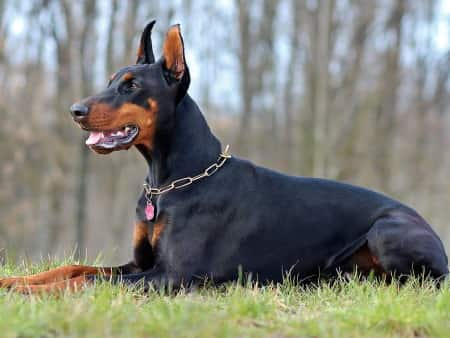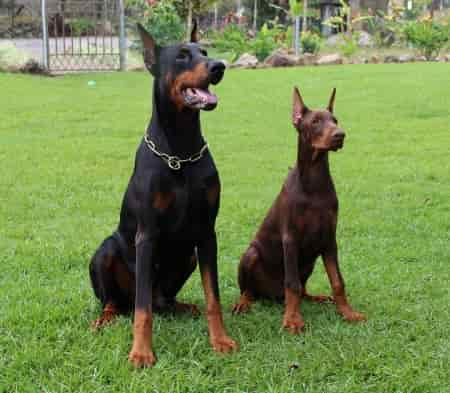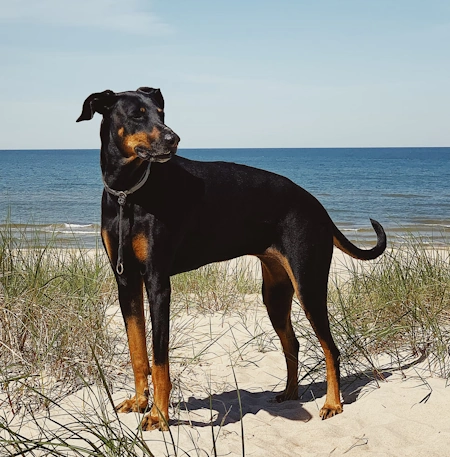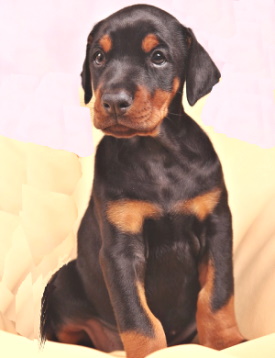Everything You Need To Know About Doberman Pinscher Dogs
Doberman Pinscher dogs originated in Apolda, Thueringen, Germany, during the 1860s, making them a relatively new breed compared to many others. Their development story is pretty unique and closely tied to the job of the breeder.
Louis Dobermann, a German tax collector and dog catcher, was the mastermind behind the breed.
 Courtesy F.Moreno
Courtesy F.MorenoBecause part of Louis’ job required him to travel through crime-heavy areas, he often found himself dealing with hostile, negligent taxpayers and their aggressive, snarling guard dogs.
Increasingly, concerned for his safety, Louis realized he needed a dog that was not only loyal and protective but also strong and intimidating to take with him on his rounds.
With access to a variety of dogs through his catcher's work and his own personal kennel stock, Louis began crossbreeding dogs including Beaucerons, Greyhounds, Manchester Terriers, and German Pinschers to create the ideal protective dog. Before long, the Doberman, named after him (with one “n” dropped), was born.
Doberman Pinscher dogs were unknown to the rest of the world until 1876 when the breed was first shown.
AKC Recognition in the Working Dog Group
With the public being intrigued and impressed, popularity of this new breed grew quickly. However, the American
Kennel Club would not recognize this kind of dog as an actual breed for another 32 years.
Today, the Doberman is ranked at number 15 on the AKC's Most Popular Dog Breeds for the year 2023.
Although most people see the Doberman as a personal protector, the truth is this breed has been used successfully for
law enforcement and military work, excelled in a search and rescue, obedience and show competitions, for tracking, and even for
therapy services.
While serving in World War II, alongside troops, twenty-five Dobermans lost their lives. For this sacrifice and valor, they have been honored with a commemorative statue at the World War II War Dog Memorial, at the Naval Base in Guam.
On a lighter note, the Dobie has added his charisma to a few roles in the movies including "Father of the Bride" part I and II, as well as a significant role in the movie "Hugo".
 Courtesy: PublicDomainPictures
Courtesy: PublicDomainPicturesDoberman Pinscher Appearance
The Doberman is of medium-large size and is squarely and compactly built. His torso is muscular and powerful, signifying great endurance and speed.
Regarding height and weight:
Males typically measure: between 26 and 28 inches at the withers
while weighing up to 88 pounds.
Females measure: between 24 and 26 inches but usually weigh less, sometimes as little as 65 pounds.
However, both males and females of this breed share the same muscular body structure.
Coat: Smooth-haired, short, hard, thick and close lying.
Colors: Most recognizably, the coat is black with dark brown markings, but Doberman Pinscher dogs also come in various shades
of
red, blue, and fawn (Isabella), as well as rare white varieties,
with sharply defined markings of rust.
However, the color of the nose is unique to the coat to include: dark brown on reddish colored dogs, black on black dogs, dark tan on fawn colored dogs, pink on cream colored dogs, and a dark gray on bluish colored dogs.
Albinism – “white coated” and “white factored” Dobermans also exist due to the expression of a recessive gene related to albinism. White-coated Dobermans or Albinos, never have patches of pigment anywhere on their hair or skin, and have blue eyes.
Their lack of pigment makes them prone to health issues including light sensitivity, skin lesions or tumors, and skin damage.
A DNA test can now determine if a Doberman is a carrier of the gene responsible for this mutation.
Ears: Most Doberman dogs have the ears taped for several months or cropped, helping them to stand erect although ears left natural are also accepted by the American Kennel Club.
Tail: The tail is also docked in most cases while only a few days old, but if left in tact, its appearance would be similar to a hound’s tail.
A frequently asked question concerns why the tails are docked. Here's the answer:
The original reason for tail docking was supposedly because it interfered with their work as police or service dogs. And, because
it prevented criminals from grabbing them by their tail. However, it has been noted by some dog lovers that docked tails make it more uncomfortable for the Dobie to be in a sitting position.
Although
both ear taping/cropping and tail docking is done frequently, it is banned in several states and countries including being considered illegal in Europe. In some countries, the showing of dogs that have been cropped or docked is also prohibited as well.
Currently, the AKC has not followed suit in initiating a ban.
Head: The wedge-shaped widening towards the base of the ears, with cheeks flat and muscular. Nose solid black on black dogs, dark brown on red ones, dark gray on blue ones, dark tan on fawns.
Eyes: Almond shaped and
moderately deep set. Iris color from medium to darkest brown in black
dogs. In other coats - reds, blues, and fawns the color of the iris
blends with that of the markings, the darkest shade being preferred.
Teeth: Dobermans have 42 correctly placed white teeth that are strongly developed and meet in a true scissors bite.
 Courtesy Unsplash
Courtesy UnsplashCharacteristics
of Doberman Pinscher Dogs
The Doberman Pinscher dog breed is known, in general, to be an extremely loyal, confident and trustworthy dog, more so in fact than many other breeds.
Bear in mind when I say "in general", it's because no two Dobies are alike, with some being quite shy or veering away from the typical stereotype.
With that said, the Doberman is an affectionate breed that bonds closely with his family, although some will be gravitate even more to one member of the family, earning them the moniker "Velcro dogs."
Dobies thrive on a close connection with those they love, in fact they insist upon being involved, and become devoted natural protectors of family and home. As a watchdog, they can't be beat - awesome appearance along with superior intelligence and alertness.
An active family that likes to take long walks or hikes will enjoy having an athletic companion with energy to spare.
Personality And Temperament
Most people immediately think of watch or guard dogs associated with this breed and while Dobermans do possess traits
that make them protective, they are also very dedicated, affectionate, tolerant, and loving.
Dobermans tend to move into their a protective mode when you take them out for walks. For example, if you stop to talk with someone, they'll step slightly between the two of you, in a subtle move. You may not even notice this as it's so calmly done without fanfare.
Once back home, he'll return to being your fun and joyful pet and if friends stop by, he'll show them respect if it's mutual.
However, Doberman Pinschers are not a breed for first-time dog owners. They require experienced handlers who can assume the role of pack leader, as this breed tends to have an alpha personality.
With their strong-willed nature, they thrive under owners who exhibit authority, confidence, and consistency.
Regarded by experts as one of the most intelligent dog breeds, Dobermans possess a solid foundation for training. However, the importance of proper training cannot be overstated.
Establishing clear leadership and reinforcing positive behavior throughout their lifetime is essential. A reward-based training approach is particularly effective in encouraging good conduct.
When trained and socialized from a young age, Dobermans can excel as therapy dogs, showcasing their versatility and gentle nature. Despite their formidable appearance, when raised by the right owner and from a reputable breeder, they are incredibly affectionate and eager to please.
Their desire to be loved and appreciated makes them truly devoted family companions and the right match for experienced handlers.
 Courtesy: yamaBSM
Courtesy: yamaBSMGrooming the Doberman
Dobies have a very short coat that is quite thick and hard. Depending on the actual dog, a gray undercoat grows around
the neck area, although it cannot be seen. While black and brown are the more common colors, there is a pure white
albino type of Doberman.
Dobermans are not considered hypoallergenic. They also not considered high maintenance dogs, but a little daily attention to brushing will keep the above average shedding from gathering into piles of hair around the house. A Roomba would be a big help too!
Brushing also provides air circulation, encourages blood flow, as well as adds a nice sheen to the coat. Just as important, your dog will enjoy it!
During the spring and fall, when much heavier shedding occurs, more frequent attention to grooming will be needed.
While the Dobie's coat does not generally need clipping, dogs being entered into conformance shows are routinely clipped and trimmed for a more polished appearance.
Ears: Inspect ears weekly and carefully clean if necessary. Closer attention is needed to ears that are folded over and not cropped as these are hiding places for mites and other parasites. Your vet can show you how to clean ears gently, or you can follow our ear cleaning guide.
Nails: Trim nails at least monthly or sooner if you hear them clicking when your dog crosses the floor. Long nails can cause problems, so even if your dog runs at the sight of nail clippers, don't put it off.
One way to handle a nail trim in a much easier and less traumatic way, is to use a dremel. Check out this amazing tool for the best solution.
Teeth: Brush teeth daily, or as often as possible. It's been proven that well-maintained teeth can help a dog live longer and healthier. Uncooked bones can be beneficial in dealing with plaque, as can a water additive. You may need to have your Dobie's teeth professionally cleaned on occasion.
Bathing: Unless he develops a bad odor, or has been into something to get extra dirty, a bath about every 4 to 6 weeks should be sufficient. More often tends to cause dry skin and is not recommended.
Here are some popular tools to help with grooming Doberman dogs:
